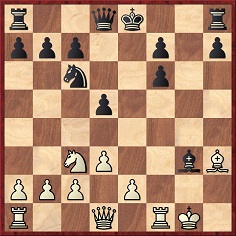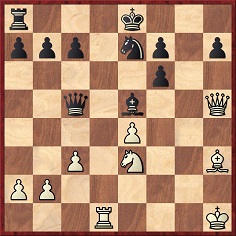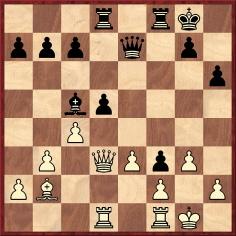
Edward Winter
Jeroen van de Weijer is interested in the Paris Opening, 1 Nh3, and gives some interesting examples of its successes.
Robert Harnett – H.D. Müller
Guernsey, 1980
Paris Opening
1 Nh3 d5 2 g3 e5 3 f4 Bxh3 4 Bxh3 exf4 5 O-O fxg3 6 e4 gxh2+ 7 Kh1 dxe4

8 d3 Nf6 9 Nc3 exd3 10 Bg5 Be7 11 Qf3 O-O 12 Rae1 Nc6 13 Qg2 Nh5 14 Bxe7 Nxe7 15 Bg4 d2 16 Re5 Nf6 17 Rxf6 gxf6 18 Rd5 Qb8 19 Rh5 Kg7 20 Qxd2 Rh8 21 Qh6+ Kg8 22 Ne4 Resigns.
The idea goes back to Tartakower:
Savielly Tartakower – A. Lilienthal
Paris, 1933
Paris Opening
1 Nh3 d5 2 g3 e5 3 f4 Bxh3 4 Bxh3 exf4 5 O-O fxg3 6 hxg3 Nf6 7 d3 Nc6 8 Nc3 Bd6 9 Bg5 Bxg3 10 Bxf6 gxf6

11 e4 Rg8 12 Nxd5 Be5+ 13 Kh1 Qd6 14 c3 Rg3 15 Qh5 Rxd3 16 Rad1 Rxd1 17 Rxd1 Ne7 18 Ne3 Qc5 19 Qxh7 Resigns.
Our correspondent also quotes the following remarkable game:
Hugh Myers – Tirso Alvarez
Santo Domingo, 1966
Paris Opening
1 Nh3 d5 2 g3 e5 3 f4 Bxh3 4 Bxh3 exf4 5 O-O fxg3 6 e4 gxh2+ 7 Kh1 dxe4 8 Nc3 Nf6 9 d3 exd3 10 Bg5 dxc2

(‘And yet another one. I claim a world record for most pawns gambitted in the first ten moves: six’ – Myers on page 26 of Exploring the Chess Openings.) 11 Qf3 Be7 12 Qxb7 Nbd7 13 Bxd7+ Nxd7 14 Bxe7 Kxe7 15 Nd5+ Kf8 16 Nxc7 Nc5 17 Ne6+ Nxe6 18 Qxf7 mate.
Regarding the Tartakower v Lilienthal game above, the following endnote is on pages 259-260 of Chess Explorations:

Position after 18...Qc5
On page 415 of the 14 August 1938 CHESS Tartakower gave the finish as ‘19 QxRP and White wins easily’. In 1995 Richard Forster pointed out that after 19 Qxh7 Black could have resisted with 19...f5 20 Nxf5 Qf2. Our correspondent also mentioned that 19 Bd7+ would have won easily: A) 19...Kf8 20 Qh6+ Kg8 21 Nf5 Nxf5 22 Bxf5, or B): 19...Kd8 20 Qxf7 c6 21 Bg4+ Kc7 22 Rd7+ Kb6 23 Qb3+ Ka5 24 Nc4+. In the latter line the alternative 23...Qb5 loses to 24 Nc4+ Kc5 25 Qa3+ Kxc4 26 Be2 mate (Myers).
Another of Tartakower’s experiments was referred to in C.N. 173: against Opočenský at Paris, 1925, he played 1 e4 e5 2 g3.
From Michael Macdonald-Ross (Harrow-on-the-Hill, England):
‘Readers interested in the history of irregular openings should get to know the work of Hugh Myers, who is undoubtedly the world’s leading authority on such matters. His little magazine, The Myers Openings Bulletin, has many interesting (and sometimes original) pieces of historical research on opening theory, and his book Exploring the Chess Openings is a minor classic.’
In C.N. 124 it was stated that the idea of 1 Nh3 goes back to Tartakower, and a 1933 example was published. In Batsford Chess Openings, however, 1 Nh3 is called the Amar Opening, and a 1932 game in which Amar beat Tartakower with it is given (as well as a 1932 game in which Tartakower was White). How did the idea originate, and who was Amar?
We subsequently found an earlier (1908) game beginning 1 Nh3 and gave the opening in C.N. 1745 (see page 102 of Chess Explorations):
1 Nh3 d5 2 g3 e5 4 f3 Bd6 4 Nf2 Nf6 5 e3 O-O 6 Bg2 Be6 7 d3 Nc6 8 O-O Qd7 (E. Delmar-S.T. Sharp, Rice Trophy Tournament, 1908. The game was drawn in 54 moves. Source: American Chess Bulletin, August 1908, page 159.
In an endnote on page 260 of Chess Explorations we mentioned that Tartakower wrote an article about 1 Nh3 on pages 333-334 of the November 1932 Wiener Schachzeitung.
Gunter Müller (Bremen, Germany) sends an extract from Exploring the Chess Openings by Hugh E. Myers. From this we learn that Amar was a Parisian amateur and does not, as Harding apparently guessed in Irregular Openings, mean Absolutely Mad and Ridiculous.
Hugh Myers (Davenport, IA, USA) informs us:
‘Tartakower wrote (I have this from a Spanish edition (Argentina) of Ideas modernas en las aperturas de ajedrez) that the Amar Opening was 1 Nh3 2 d5 g3 e5 3 Bg2 (“the first tournament game – an ‘exhibition game’ Tartakower v Moroni was played in Paris in 1932 – in which it was employed was Wechsler v Tomassewicz, played during the championship of ‘The Left Bank’ in Paris, during month of March 1933)”, and that the Amar Gambit was 1 Nh3 d5 2 g3 e5 3 f4 (Amar v Tartakower, “analytical game”, played in Paris in 1932.)’
Since the opening 1 Nh3 is known as the Paris Opening, why not surrender to romanticism and play the move against the French Defence? Can it be that bad to begin 1 e4 e6 2 Nh3?
The only game with this opening that we have been able to locate is Wolf-Zinkl (played 1897/98): 1 e4 e6 2 Nh3 d5 3 f3 dxe4 4 fxe4 Bc5 5 Qh5 Nd7 6 c3 Ngf6 7 Qf3 e5 8 d3 O-O and Black eventually won. The full score is given on pages 192-193 of the December 1898 Wiener Schachzeitung, which notes that 2 Nh3 was first played by Wolf against the same opponent in a match in 1897.
A further game is added here:
J. Kornreich – Edgard Colle
Belgian Championship, Antwerp, December 1929
Paris Opening
1 Nh3 e5 2 g3 d5 3 d4 exd4 4 Qxd4 Nc6 5 Qd1 Nf6 6 Bg2 Bb4+ 7 c3 Bxh3 8 Bxh3 Bc5 9 O-O h6 10 b3 O-O 11 Bb2 Ne4 12 Nd2 Qe7 13 Bg2 Rad8 14 Qc2 f5 15 e3 Ne5 16 Rad1 Ng4 17 Nxe4 fxe4 18 Qe2 Ne5 19 c4 Nf3+ 20 Bxf3 exf3 21 Qd3

21...Qe6 22 Rfe1 Bb4 23 cxd5 Qh3 24 Qf1 Qd7 25 e4 Bxe1 26 Qxe1 Qh3 27 Qf1 Qxf1+ 28 Kxf1 Rfe8 29 e5 Rd7 30 Rd3 Red8 31 Rxf3 Rxd5 32 e6 Rf8 33 e7 Re8 34 Re3 Rd7 35 Ba3 b6 36 Rf3 c5 37 Rf8+ Rxf8 38 exf8(Q)+ Kxf8 39 Ke2 Kf7 40 f4 h5 41 h3 Ke6 42 g4 g6 43 Bb2 hxg4 44 hxg4 Rh7 45 White resigns.
Source: Gedenkboek-Colle/Mémorial Colle by M. Euwe (Liège, 1935), pages 115-117. Only the first 28 moves were given on page 585 of L’Echiquier, 16 January 1930.
To the Chess Notes main page.
To the Archives for other feature articles.
Copyright: Edward Winter. All rights reserved.